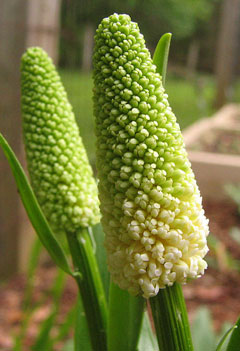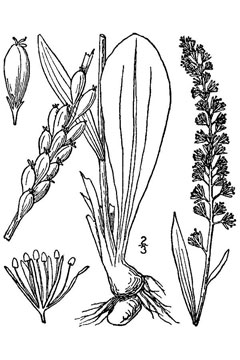 |
|
http://commons.wikimedia.org/wiki/User:Phyzome |
 |
| USDA-NRCS PLANTS Database / Britton, N.L., and A. Brown. 1913. An illustrated flora of the northern United States, Canada and the British Possessions. Vol. 1: 489. |
Translate this page:
Summary
Physical Characteristics

 Chamaelirium luteum is a PERENNIAL growing to 0.5 m (1ft 8in) by 0.3 m (1ft).
Chamaelirium luteum is a PERENNIAL growing to 0.5 m (1ft 8in) by 0.3 m (1ft).
See above for USDA hardiness. It is hardy to UK zone 4. It is in flower from May to June. The species is dioecious (individual flowers are either male or female, but only one sex is to be found on any one plant so both male and female plants must be grown if seed is required). . The plant is not self-fertile.
Suitable for: light (sandy) and medium (loamy) soils. Suitable pH: mildly acid soils and can grow in very acid soils.
It can grow in semi-shade (light woodland) or no shade. It prefers moist soil.
UK Hardiness Map
US Hardiness Map
Synonyms
C. carolinianum. Helonias dioica. H. lutea. Veratrum luteum.
Plant Habitats
Woodland Garden Dappled Shade; Shady Edge;
Edible Uses
References More on Edible Uses
Medicinal Uses
Plants For A Future can not take any responsibility for any adverse effects from the use of plants. Always seek advice from a professional before using a plant medicinally.
Adaptogen Diuretic Emetic Tonic Uterine tonic Vermifuge
Blazing star is a traditional remedy of the North American Indians where it was used mainly as a woman's herb[254]. It is widely used in Western herbal medicine where it is seen as a balancing herb for the female reproductive system and has proved to be a beneficial remedy for menstrual problems and ovarian cysts - it can also be of help in the menopause[254]. The root is adaptogen, diuretic, emetic, uterine tonic and vermifuge[4, 46, 61, 105, 238]. Small doses of the dried and powdered root are used[222]. It is employed in the treatment of amenorrhoea, dysmenorrhoea and leucorrhoea[207] and also for a variety of ailments associated with the male and female reproductive organs[222]. It should be used with caution since an excess causes vomiting[238]. The root is harvested in the autumn and dried for later use[238].
References More on Medicinal Uses
The Bookshop: Edible Plant Books
Our Latest books on Perennial Plants For Food Forests and Permaculture Gardens in paperback or digital formats.

Edible Tropical Plants
Food Forest Plants for Hotter Conditions: 250+ Plants For Tropical Food Forests & Permaculture Gardens.
More

Edible Temperate Plants
Plants for Your Food Forest: 500 Plants for Temperate Food Forests & Permaculture Gardens.
More

More Books
PFAF have eight books available in paperback and digital formats. Browse the shop for more information.
Shop Now
Other Uses
References More on Other Uses
Cultivation details
Requires a moist fertile humus-rich acidic soil in sun or light dappled shade[1, 200]. Prefers a cool peaty soil[233]. Plants are dioecious, male and female plants must be grown if seed is required[270].
References Carbon Farming Information and Carbon Sequestration Information
Temperature Converter
Type a value in the Celsius field to convert the value to Fahrenheit:
Fahrenheit:
The PFAF Bookshop
Plants For A Future have a number of books available in paperback and digital form. Book titles include Edible Plants, Edible Perennials, Edible Trees,Edible Shrubs, Woodland Gardening, and Temperate Food Forest Plants. Our new book is Food Forest Plants For Hotter Conditions (Tropical and Sub-Tropical).
Shop Now
Plant Propagation
Seed - sow as soon as it is ripe just below the surface of a peat/sand mix in pots in a cold frame[164]. Keep cool and moist. Germination usually takes place within 1 - 6 months at 10°c[164]. When large enough to handle, prick the seedlings out into individual pots and grow them on in pots plunged in a nursery bed for 1 - 2 years, giving protection from severe weather. Plant out in spring when the plants are large enough[164]. Division.
Other Names
If available other names are mentioned here
Native Range
NORTHERN AMERICA: Canada (Ontario), United States (Massachusetts, Michigan, New Jersey, New York, Ohio, Pennsylvania, Illinois, Arkansas, Florida (north), Georgia, Kentucky, Maryland, Mississippi, North Carolina, South Carolina, Tennessee, Virginia)
Weed Potential
Right plant wrong place. We are currently updating this section.
Please note that a plant may be invasive in one area but may not in your area so it's worth checking.
Conservation Status
IUCN Red List of Threatened Plants Status :

Growth: S = slow M = medium F = fast. Soil: L = light (sandy) M = medium H = heavy (clay). pH: A = acid N = neutral B = basic (alkaline). Shade: F = full shade S = semi-shade N = no shade. Moisture: D = dry M = Moist We = wet Wa = water.
Now available:
Food Forest Plants for Mediterranean Conditions
350+ Perennial Plants For Mediterranean and Drier Food Forests and Permaculture Gardens.
[Paperback and eBook]
This is the third in Plants For A Future's series of plant guides for food forests tailored to
specific climate zones. Following volumes on temperate and tropical ecosystems, this book focuses
on species suited to Mediterranean conditions—regions with hot, dry summers and cool, wet winters,
often facing the added challenge of climate change.
Read More
Expert comment
Author
(L.)A.Gray.
Botanical References
43200270
Links / References
For a list of references used on this page please go here
Readers comment
© 2010, Plants For A Future. Plants For A Future is a charitable company limited by guarantee, registered in England and Wales. Charity No. 1057719, Company No. 3204567.